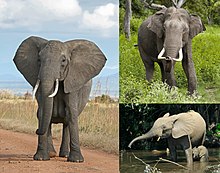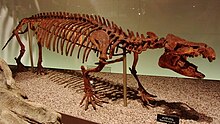
Back Slurpdiere Afrikaans Rüsseltiere ALS خرطوميات Arabic فيليات ARZ Proboscidea AST Fuzoldunol (Proboscidea) AVK Xortumlular Azerbaijani Хобатныя Byelorussian Хобатныя BE-X-OLD Хоботни Bulgarian
| Proboscidea | |
|---|---|

| |
| Proboscidean diversity: Indian elephant, Elephas maximus indicus, African bush elephant, Loxodonta africana and African forest elephant, Loxodonta cyclotis | |

| |
| Skeleton of Moeritherium | |
| Scientific classification | |
| Domain: | Eukaryota |
| Kingdom: | Animalia |
| Phylum: | Chordata |
| Class: | Mammalia |
| Mirorder: | Tethytheria |
| Order: | Proboscidea Illiger, 1811 |
| Subclades | |
Proboscidea (/ˌprɒbəˈsɪdiə/; from Latin proboscis, from Ancient Greek προβοσκίς (proboskís) 'elephant's trunk') is a taxonomic order of afrotherian mammals containing one living family (Elephantidae) and several extinct families. First described by J. Illiger in 1811, it encompasses the elephants and their close relatives.[1] Three species of elephant are currently recognised: the African bush elephant, the African forest elephant, and the Asian elephant.
Extinct members of Proboscidea include the deinotheres, mastodons, gomphotheres and stegodonts. The family Elephantidae also contains several extinct groups, including mammoths and Palaeoloxodon. Proboscideans include some of the largest known land mammals. The largest land mammal of all time may have been a proboscidean; the elephant Palaeoloxodon namadicus has been estimated to be up to 5.2 m (17.1 ft) at the shoulder and may have weighed up to 22 t (24.3 short tons), surpassing the paraceratheres, the otherwise largest known land mammals, though this estimate was made based on a single fragmentary femur and is speculative.[2] The largest extant proboscidean is the African bush elephant, with a record of size of 4 m (13.1 ft) at the shoulder and 10.4 t (11.5 short tons).[2] In addition to their enormous size, later proboscideans are distinguished by tusks and long, muscular trunks, which were less developed or absent in early proboscideans.
- ^ Illiger, Johann Karl Wilhelm (1811). Prodromus Systematis Mammalium et Avium: Additis Terminis Zoographicis Utriusque Classis, Eorumque Versione Germanica. Berolini: Sumptibus C. Salfeld. p. 62.
- ^ a b Larramendi, A. (2016). "Shoulder height, body mass and shape of proboscideans" (PDF). Acta Palaeontologica Polonica. 61. doi:10.4202/app.00136.2014. S2CID 2092950.
© MMXXIII Rich X Search. We shall prevail. All rights reserved. Rich X Search